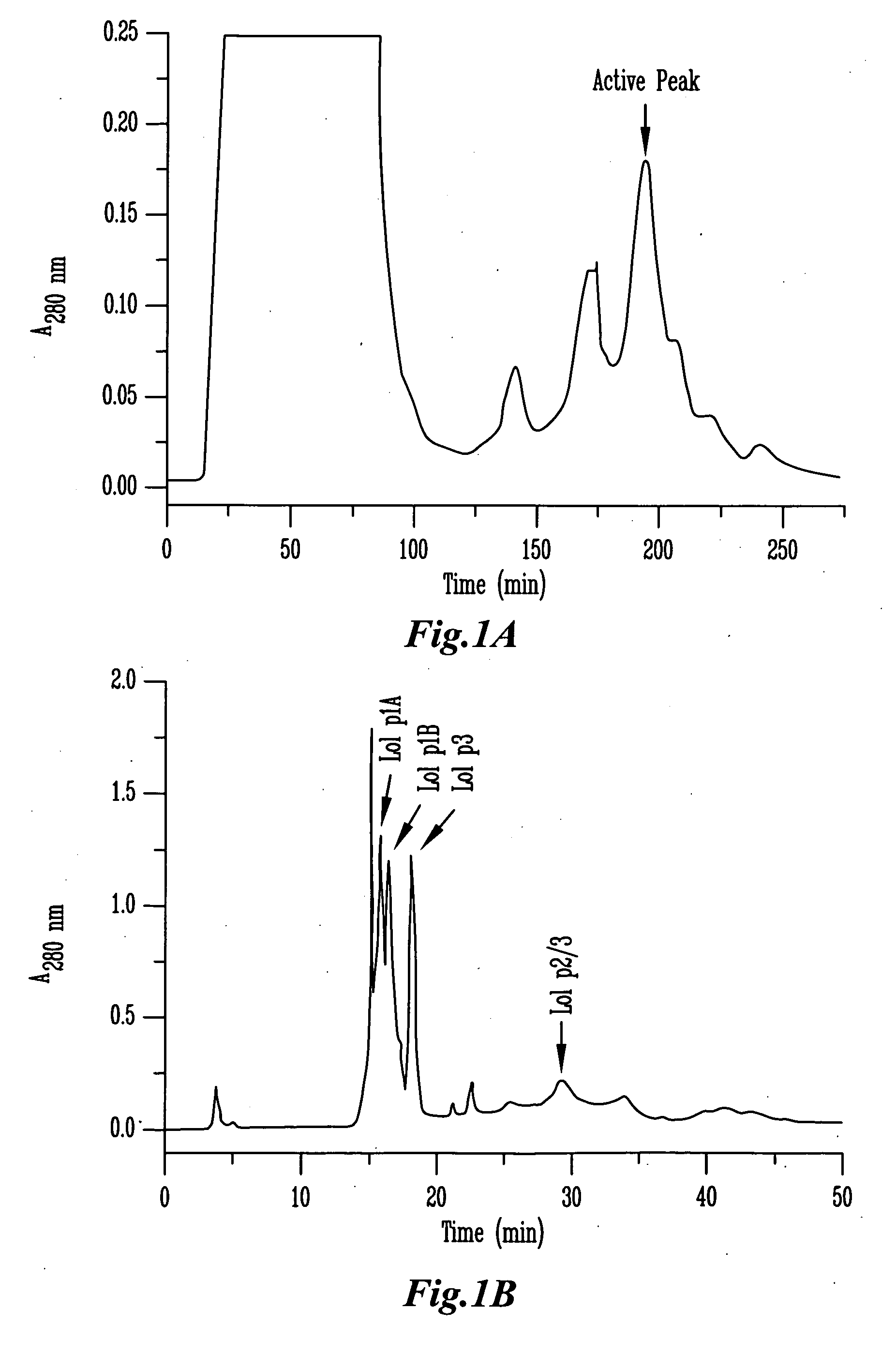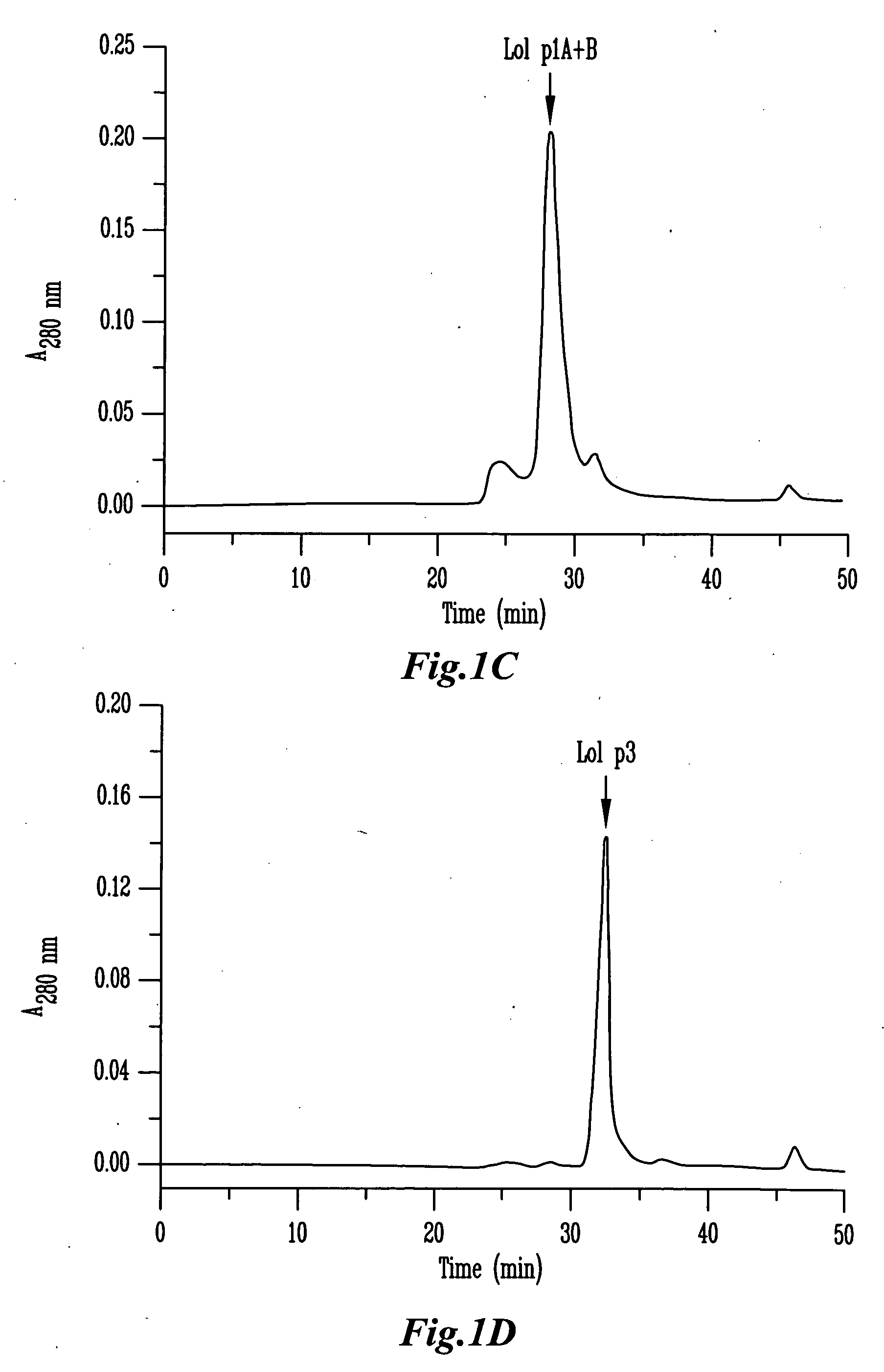Plant cell wall loosening activity of group 2/3 allergens of grass pollen
a technology of plant cell wall and allergen, which is applied in the field of plant cell wall loosening activity of group 2/3 allergens of grass pollen, can solve problems such as paper weakening, and achieve the effects of increasing the stress relaxation of isolated cell walls, quick wall extension, and weakening of hydrogen bonds
- Summary
- Abstract
- Description
- Claims
- Application Information
AI Technical Summary
Benefits of technology
Problems solved by technology
Method used
Image
Examples
example 1
Chemical Materials
[0114]Ammonium persulfate (electrophoresis reagent), Coomassie brilliant blue R-250, and Ponceau A were purchased from Sigma-Aldrich Co. (St. Louis, Mo.) while methanol (HPLC grade) was purchased from J. T. Baker (Mallinckrodt Baker, Inc., Phillipsburg, N.J.). All other chemicals used for electrophoresis, such as acrylamide, N,N′-methylenebisacrylamide, SDS, Tris, glycine, and urea, were obtained from Research Organics, Inc. (Cleveland, Ohio). Dr. David G. Klapper (Department of Microbiology and Immunology, University of North Carolins School of Medicine, Chapel Hill, N.C.) provided mouse monoclonal antibody (anti-site D) which was raised against Lol p 1. Rabbit polyclonal antibodies, which raised against natural Lol p 2 or recombinant Phl p 2, were supplied by Dr. Alessandro Sidolli (Department of Biological and Technological Research, San Raffaele Scientific Institute, Milano, Italy) and Dr. Rudolf Valenta (Institute of General and Experimantal Pathology, AKH, Un...
example 2
Plant Materials
[0115]Ryegrass (Lolium perenne) and timothy (Phleum pretense) grass pollen were purchased from Greer Laboratories, Inc. (Lenoir, N.C.). Wheat (Triticum aestivum L., cv. Pennmore winter) seeds were grown in moist Metro-Mix 360 growing medium (Scotts-Sierra Horticultural Products Co., Marysville, Ohio) at 27-29° C. in complete darkness for 3 days. Cucumber (Cucumis sativus L. cv. Burpee Pickler) seeds were grown in wet germination paper in a dark room at 27-29° C. for 4 days. Cucumber hypocotyls were quickly excised from the seedlings under room light and directly frozen at −20° C. Wheat coleoptiles were immediately cut, gently abraded by rubbing them between two fingers coated with a slurry of well washed carborundum (320 grit; Fisher Scientific Inc., Fair Lawn, N.J.), separated from primary leaves, and then stored at −20° C. prior to use. Maize ears were collected at the beginning of August 2000 from maize (Zea mays L.) plants grown in a summer field (State College, P...
example 3
Purification of β-Expansins and Group 2 / 3 Allergens
[0116]Purification of β-expansins and group 2 / 3 allergens from ryegrass pollen was performed as previously described for maize β-expansins with some modifications. Briefly, pollen samples were extracted in 50 mM NaAc / HAc (pH 4.5) for 1 hour at 4° C. The extract was centrifuged at 15,000 g at 4° C. and was first loaded onto a SP-Sepharose Fast Flow (Amersham Pharmacia Biotech AB, Uppsala, Sweden) column equilibrated in 20 mM sodium acetate, pH 4.5. The column was washed with the same buffer and then a 0˜500 mM NaCl linear gradient with the hold at final gradient (500 mM NaCl) was applied to the column to elute the bound proteins. The fractions from SP-Sepharose column chromatography were desalted and concentrated by ultrafiltration. Active fractions were pooled and then loaded onto a silica-based CM-HPLC column (4.6×250 mm, Synchropak CM300 / 6.5 μm, MICRA Scientific Inc., Northbrook, Ill.). Proteins were eluted with a linear gradient ...
PUM
| Property | Measurement | Unit |
|---|---|---|
| flow rate | aaaaa | aaaaa |
| pH | aaaaa | aaaaa |
| pH | aaaaa | aaaaa |
Abstract
Description
Claims
Application Information
 Login to View More
Login to View More - R&D
- Intellectual Property
- Life Sciences
- Materials
- Tech Scout
- Unparalleled Data Quality
- Higher Quality Content
- 60% Fewer Hallucinations
Browse by: Latest US Patents, China's latest patents, Technical Efficacy Thesaurus, Application Domain, Technology Topic, Popular Technical Reports.
© 2025 PatSnap. All rights reserved.Legal|Privacy policy|Modern Slavery Act Transparency Statement|Sitemap|About US| Contact US: help@patsnap.com



